Production and Service
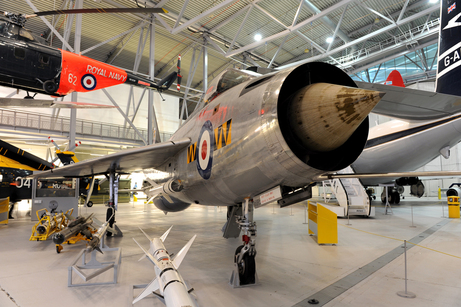
English Electric Lightning F.1 XM135 IWM Duxford - Photo Richard Hall
On 29 October 1958 the first production Lightning F.1, XM134, was rolled out, its maiden flight undertaken by Roland Beamont on 3 November 1959 from Samlesbury, with the Certificate of Airworthiness granted in December.
The next to fly XM135 took to the air on 14 November 1959. Following a stint at the Central Fighter Establishment, the aircraft was then released for operations on 14 May 1960 and went to the Air Fighting Development Squadron at Leconfield.
In due course, on 29 June 1960, 74 ‘Tiger’ Squadron received its first F.1, XM165, at Coltishall, starting a service career for the Lightning that would last for some twenty-eight years. Of course, the aircraft would be upgraded to more powerful and capable machines over time, but the basic shape throughout would be as Petter and Page had envisaged in the years just after the conclusion of the Second World War. We must honour their vision of giving the nation a true supersonic thoroughbred, one that both young and old still look upon today in awe, the same way they did when it first took to the skies.
The next to fly XM135 took to the air on 14 November 1959. Following a stint at the Central Fighter Establishment, the aircraft was then released for operations on 14 May 1960 and went to the Air Fighting Development Squadron at Leconfield.
In due course, on 29 June 1960, 74 ‘Tiger’ Squadron received its first F.1, XM165, at Coltishall, starting a service career for the Lightning that would last for some twenty-eight years. Of course, the aircraft would be upgraded to more powerful and capable machines over time, but the basic shape throughout would be as Petter and Page had envisaged in the years just after the conclusion of the Second World War. We must honour their vision of giving the nation a true supersonic thoroughbred, one that both young and old still look upon today in awe, the same way they did when it first took to the skies.
Over the coming months more Lightnings came on stream with 74 Squadron and by January 1961 conversion was complete. No 226 Operational Conversion Unit (OCU) became the only other unit to operate the F.1 and this was formed using six ex 74 Squadron aircraft in July 1963 at RAF Middleton St George. The Lightnings of 226 featured the markings of 145 Squadron, as this was the wartime shadow unit of the OCU.
It is well known that the Lightning was not known for its fuel economy, lacking range and endurance. So to overcome this, a rather crude refuelling probe was fitted. From F.1A XM169 onwards, which first flew on 16 August 1960, the probe became a standard fit and 28 further examples were built. Power was supplied by two Avon RA24R engines and this variant featured a cable duct down each side of the aircraft. The ducts were required to remove cables from within the fuselage which were considered a fire risk. XM169 went on to join 111 Squadron at RAF Wattisham in October 1964. Treble 1 had received its first Lightning F.1A in the form of XM182 in March 1961. On 28 February 1961, 56 Squadron received its first F.1A, XM171, with unit becoming the first official RAF aerobatic team when the Firebirds were formed.
As with the F.1, F.1As found their way to 226 OCU which was based at RAF Coltishall from 1964. Other F.1 and F.1As went to AFDS at RAF Binbrook, which went on to become Fighter Command Trials Unit (FCTU) in January 1966. When the FCTU was disbanded in June 1967 the aircraft went to the Binbrook Station Flight. All F.1 and F.1As had retired by 1974 having been used for roles which included Target Facility Flights at RAF Wattisham and RAF Leuchars. One was used as a station hack at RAF Leconfield which must have provided some enjoyment to those lucky enough to fly the aircraft.
Lightning F.2/2A
It is well known that the Lightning was not known for its fuel economy, lacking range and endurance. So to overcome this, a rather crude refuelling probe was fitted. From F.1A XM169 onwards, which first flew on 16 August 1960, the probe became a standard fit and 28 further examples were built. Power was supplied by two Avon RA24R engines and this variant featured a cable duct down each side of the aircraft. The ducts were required to remove cables from within the fuselage which were considered a fire risk. XM169 went on to join 111 Squadron at RAF Wattisham in October 1964. Treble 1 had received its first Lightning F.1A in the form of XM182 in March 1961. On 28 February 1961, 56 Squadron received its first F.1A, XM171, with unit becoming the first official RAF aerobatic team when the Firebirds were formed.
As with the F.1, F.1As found their way to 226 OCU which was based at RAF Coltishall from 1964. Other F.1 and F.1As went to AFDS at RAF Binbrook, which went on to become Fighter Command Trials Unit (FCTU) in January 1966. When the FCTU was disbanded in June 1967 the aircraft went to the Binbrook Station Flight. All F.1 and F.1As had retired by 1974 having been used for roles which included Target Facility Flights at RAF Wattisham and RAF Leuchars. One was used as a station hack at RAF Leconfield which must have provided some enjoyment to those lucky enough to fly the aircraft.
Lightning F.2/2A
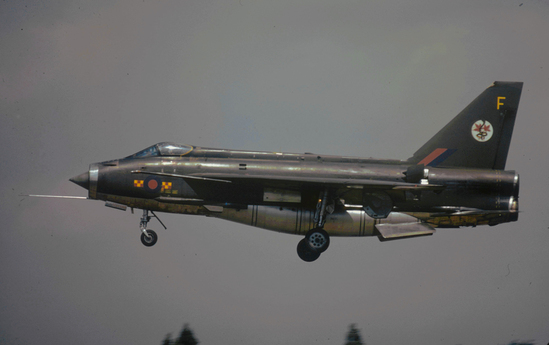
English Electric Lightning F.2A XN724 (F) - Photo via Hugh Trevor
The next model on the scene was the F.2/2A. Forty Four examples were produced but the Mark was not intended to replace the F.1/1A. Externally the variant looked the same except for a stand by DC generator which was located on the fuselage spine. However, internally the changes were quite complex. Navigational aids were improved and a liquid oxygen system was fitted. The two Avon 210s featured a fully variable reheat system. The design considered the pilot by improving the radar display and an improved instrument layout was provided.
The first F.2 to fly was XN723 on 11 July 1961 with Jimmy Dell as pilot. After a spell at Boscombe Down and then Rolls Royce, the aircraft crashed when No 2 Avon caught fire at Hucknall. This incident subsequently delayed the F.2s entry into service.
On 14 November 1962 the first F.2 delivered to the RAF was XN771. This went to AFDS at Binbrook after a test flight in the hands of Roland Beamont the previous August. No 19 Squadron became the first RAF unit to be equipped with the F.2, when XN774 was taken on charge on 17 December 1962. Following on from this, 92 Squadron received its first F.2 XN727 on 26 March 1963. At the time both 19 and 92 were based at Leconfield however, the squadrons subsequently relocated to RAF Germany with 92 going to Geilenkirchen and 19 to Gutersloh.
Further development of the Lightning envisaged the F.2 being upgraded to the F.3. However, a number of F.2s were converted into F.2As. This derivative featured a squared enlarged fin, cambered wing, a larger belly tank, and modified Avon engines which bore the designation 211R. In many ways the F.2A looked like an F.6 as it incorporated most of that type's features. The first aircraft to be converted was XN795.
The final version of the F.2A was reached with XN726, the aircraft retaining its AI.23 radar, Firestreak missiles and the nose guns of the F.2. The first flight took place with Jimmy Dell at the controls on 28 March 1968 with the aircraft being passed to 19 Squadron on 7 June. The F.2A was used by 19 and 92 Squadron until their replacement by F.4 Phantoms in early 1977.
Lightning F.3
On 14 November 1962 the first F.2 delivered to the RAF was XN771. This went to AFDS at Binbrook after a test flight in the hands of Roland Beamont the previous August. No 19 Squadron became the first RAF unit to be equipped with the F.2, when XN774 was taken on charge on 17 December 1962. Following on from this, 92 Squadron received its first F.2 XN727 on 26 March 1963. At the time both 19 and 92 were based at Leconfield however, the squadrons subsequently relocated to RAF Germany with 92 going to Geilenkirchen and 19 to Gutersloh.
Further development of the Lightning envisaged the F.2 being upgraded to the F.3. However, a number of F.2s were converted into F.2As. This derivative featured a squared enlarged fin, cambered wing, a larger belly tank, and modified Avon engines which bore the designation 211R. In many ways the F.2A looked like an F.6 as it incorporated most of that type's features. The first aircraft to be converted was XN795.
The final version of the F.2A was reached with XN726, the aircraft retaining its AI.23 radar, Firestreak missiles and the nose guns of the F.2. The first flight took place with Jimmy Dell at the controls on 28 March 1968 with the aircraft being passed to 19 Squadron on 7 June. The F.2A was used by 19 and 92 Squadron until their replacement by F.4 Phantoms in early 1977.
Lightning F.3
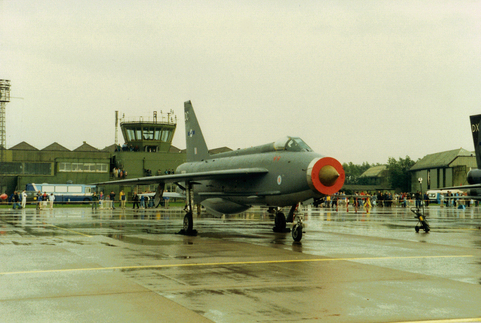
English Electric Lightning F.3 XP764 (DC) - Photo Richard Hall
The F.3 progressed Lightning development still further. The aircraft was fitted with an improved AI.23B radar, and uprated Avon 301R engines. Also fitted was the full OR946 integrated flight system along with De Havilland Red Top missiles. Firestreaks could still be carried but the cannons were removed.
Due to increased thrust and a change in the shape of the missile pylons, the rudder area required an increase in size along with reshaping of the fin.
Due to increased thrust and a change in the shape of the missile pylons, the rudder area required an increase in size along with reshaping of the fin.
A P.1B was reworked to become the first F.3. XG310 undertook its first flight as an F.3 on 18 November 1961 with Jimmy Dell as pilot. The first production F.3, XP693 (later converted to an F.6), undertook its first flight on 16 June 1962.
XP700 became the first operational F.3 Lightning on 14 April 1964 when it was delivered to RAF Leuchars. No 74 Squadron flew a mix of F.1s and F.3s until full conversion to the new model took place. Also based at Leuchars at the time was No 23 Squadron who were flying Javelins. The change over to Lightnings for No 23 began on 19 August 1964 when F.3 XP707 arrived.
With production of the F.3 in full swing, the next squadron to equip with Lightnings was 111. XP741 joined the unit in December 1964. Next 56 Squadron took on the F.3 with XR719 arriving on strength in March 1965. No 226 OCU received its first F.3 in June 1970.
For many years the USAF were of the opinion that their Lockheed U2s were beyond the reach of contemporary fighter aircraft. This thought was rather rudely challenged during the summer of 1965 when an F.3 of 111 Squadron, flying from Wattisham, intercepted a high flying U2 from Lakenheath. The Lightning attained a height of 87,500ft which must have been a bit of a surprise to the U2 pilot.
Lightning F.6
With production of the F.3 in full swing, the next squadron to equip with Lightnings was 111. XP741 joined the unit in December 1964. Next 56 Squadron took on the F.3 with XR719 arriving on strength in March 1965. No 226 OCU received its first F.3 in June 1970.
For many years the USAF were of the opinion that their Lockheed U2s were beyond the reach of contemporary fighter aircraft. This thought was rather rudely challenged during the summer of 1965 when an F.3 of 111 Squadron, flying from Wattisham, intercepted a high flying U2 from Lakenheath. The Lightning attained a height of 87,500ft which must have been a bit of a surprise to the U2 pilot.
Lightning F.6

English Electric Lightning F.6 XS904 - Photo Richard Hall
The Lightning had shown itself to be an effective fighting aircraft, however, lack of range was a major problem. It was known through flight testing of the P.1 that range could be improved by increasing the camber on the leading edge of the wing.
The only downside to this was a minor decrease in high speed handling efficiency. Lack of funding precluded the design change in earlier production models but with the improved F.3 being considered, funding was made available to test the new wing design
The only downside to this was a minor decrease in high speed handling efficiency. Lack of funding precluded the design change in earlier production models but with the improved F.3 being considered, funding was made available to test the new wing design
The new wing was fitted to F.3, XP697, and first flew on 13 August 1963. The tests were successful and all further F.3s on the production line were modified. XP697 was further reworked with a refined and bigger area rule ventral tank. This enabled much needed fuel to be carried and crucially, range to be extended. The tank could hold 4,880lbs of fuel while the forward section could be used to house a pack containing a pair of 30mm Aden cannons, feed mechanisms and ammunition. An arrestor hook was fitted, together with overwing ferry tanks with a fuel capacity 2,380Ibs. XP697 flew for the first time in F.6 configuration on 17 April 1964 in the hands of Roland Beamont.
Fifteen F.3s incorporating F.6 features (with the exception of overwing hardpoints) were built designated F.3 ER/6int. This was a bit of a mouthful so the aircraft became known as F.3A (Interim). The first aircraft XR752 was flown on 16 June 1965 and delivered to CFE on 26 October of that year and later to 23 Squadron. Most F.3As went to 5 Squadron, with XR753 being the first on 16 October 1965. Some F.3As from 23 and 5 Squadrons also found their way to 11 Squadron but most were brought up to full F.6 standard.
On 24 November, Roly Beamont tested XR768 at Samlesbury and after FCTU acceptance was completed in March 1966, the aircraft went to 74 Squadron on 1 August. This was the first true variant of the F.6 Lightning.
Deliveries of the F.6 began in early 1967, with 5 Squadron the first recipients, the initial aircraft the squadron took on charge was XS894. No 74 moved overseas to the Far East on 1 June 1967 where its Lightnings replaced 64 Squadron's Javelins. No 11 Squadron took over at Leuchars in place of 74 in May, where together with 23 they began reforming with F.6’s in exchange for their F.3s and F.3As. Delivery of XS938 on 28 August 1967 to 23 marked the last production Lightning for the RAF.
Lightning T.4 and T.5
The Lightning was a radical change for most pilots over the Hunter and Javelin that were equipping RAF squadrons in the 1960s. It was obvious that a pilot could not be expected to fly the Lightning with just advice from an instructor standing on the wing and talking over the pilots shoulder. Therefore a training version was required which was to become the T.4.
The T.4 featured a side by side seating arrangement which resulted in the aircraft having a bulged appearance around the cockpit. This arrangement was chosen over a tandem configuration as it meant less design change to existing systems and controls. Effects on the aircraft's performance were minimal through the two seat arrangement, although the cannon armament was removed to allow for the weight of the second ejection seat. An order for 20 aircraft was placed with the first deliveries scheduled for June 1962.
Fifteen F.3s incorporating F.6 features (with the exception of overwing hardpoints) were built designated F.3 ER/6int. This was a bit of a mouthful so the aircraft became known as F.3A (Interim). The first aircraft XR752 was flown on 16 June 1965 and delivered to CFE on 26 October of that year and later to 23 Squadron. Most F.3As went to 5 Squadron, with XR753 being the first on 16 October 1965. Some F.3As from 23 and 5 Squadrons also found their way to 11 Squadron but most were brought up to full F.6 standard.
On 24 November, Roly Beamont tested XR768 at Samlesbury and after FCTU acceptance was completed in March 1966, the aircraft went to 74 Squadron on 1 August. This was the first true variant of the F.6 Lightning.
Deliveries of the F.6 began in early 1967, with 5 Squadron the first recipients, the initial aircraft the squadron took on charge was XS894. No 74 moved overseas to the Far East on 1 June 1967 where its Lightnings replaced 64 Squadron's Javelins. No 11 Squadron took over at Leuchars in place of 74 in May, where together with 23 they began reforming with F.6’s in exchange for their F.3s and F.3As. Delivery of XS938 on 28 August 1967 to 23 marked the last production Lightning for the RAF.
Lightning T.4 and T.5
The Lightning was a radical change for most pilots over the Hunter and Javelin that were equipping RAF squadrons in the 1960s. It was obvious that a pilot could not be expected to fly the Lightning with just advice from an instructor standing on the wing and talking over the pilots shoulder. Therefore a training version was required which was to become the T.4.
The T.4 featured a side by side seating arrangement which resulted in the aircraft having a bulged appearance around the cockpit. This arrangement was chosen over a tandem configuration as it meant less design change to existing systems and controls. Effects on the aircraft's performance were minimal through the two seat arrangement, although the cannon armament was removed to allow for the weight of the second ejection seat. An order for 20 aircraft was placed with the first deliveries scheduled for June 1962.
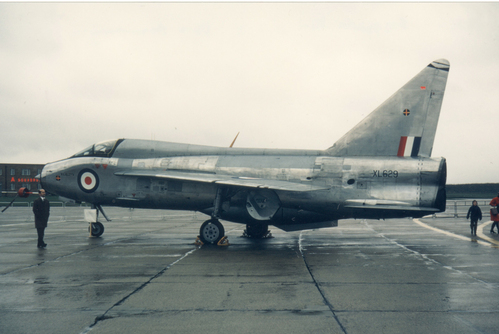
English Electric Lightning T.4 XL629 - Photo via Hugh Trevor
XL628 was the first T.4 prototype and was derived from an F.1A. The first flight in the hands of Roland Beamont took place on 6 May 1959.
This aircraft was lost over the Irish Sea on 1 October 1959 after 41 hours of flight. It was suspected that the aircraft crashed due to the fin collapsing at high speed.
A second prototype, XL629, had joined the two seat development programme in September 1959.
This aircraft was lost over the Irish Sea on 1 October 1959 after 41 hours of flight. It was suspected that the aircraft crashed due to the fin collapsing at high speed.
A second prototype, XL629, had joined the two seat development programme in September 1959.
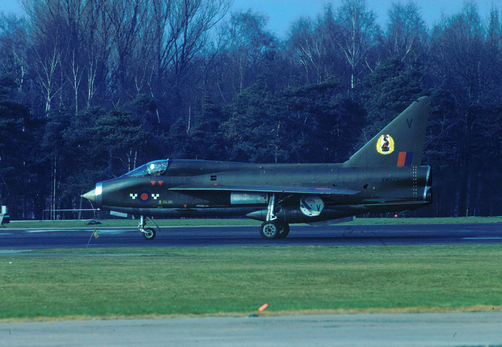
English Electric Lightning T.4 XM973 (V) - Photo via Hugh Trevor
On 15 July 1960 the first production T.4, XM966, was flown, with XM970 becoming the first T.4 into RAF service on 2 October 1961. XM970 also went to the Paris Airshow in 1962 for display.
The vast majority of T.4s served with the Lightning Conversion Unit (LCU) and 226 OCU.
The last T.4s were delivered in January 1963. In all 19 T.4s were built along with the 2 prototypes.
The vast majority of T.4s served with the Lightning Conversion Unit (LCU) and 226 OCU.
The last T.4s were delivered in January 1963. In all 19 T.4s were built along with the 2 prototypes.

English Electric Lightning T.5 XS422 - Photo Richard Hall
The Lightning T.5 was based on the F.3 and was powered by twin Avon 301s (later 302) which could propel the aircraft to over Mach 2 at 36,000ft. The first T.5, XM967, was initially a T.4 which was taken from the production line and transported to Filton.
Bristols had been contracted to manufacture the forward fuselages of the T.5. The first, XM567, flew on 3 March 1962 with Jimmy Dell as pilot. Twenty two more T.5s were built the first being delivered to 226 OCU at Coltishall in April 1965.
Bristols had been contracted to manufacture the forward fuselages of the T.5. The first, XM567, flew on 3 March 1962 with Jimmy Dell as pilot. Twenty two more T.5s were built the first being delivered to 226 OCU at Coltishall in April 1965.
In all 278 Lightnings were delivered to the RAF the last by August 1967. The Lightning saw active service through the 1970s but was eventually replaced by the Phantom. By 1975 only two squadrons had Lightnings on strength, these being 5 and 11. The two Squadrons flew a mix of F.3s, F.6s and twin seat T.5s. The disbandment of the Lightning Training Flight in April 1987 sealed the fate of the F.3 in RAF service but a couple were retained for display purposes.
5 Squadron officially disbanded on 31 December 1987, with their last sortie flown on 10 December 1987. This left 11 Squadron as the sole operator of the Lightning with their disbandment coming on 30 April 1988. The last flight of a Lightning in RAF service was undertaken by Squadron Leader John Alderton, former OC of 'B' Flight, 11 Squadron.
5 Squadron officially disbanded on 31 December 1987, with their last sortie flown on 10 December 1987. This left 11 Squadron as the sole operator of the Lightning with their disbandment coming on 30 April 1988. The last flight of a Lightning in RAF service was undertaken by Squadron Leader John Alderton, former OC of 'B' Flight, 11 Squadron.
The Lightning was replaced by Panavia Tornado F.2 and F.3 ADV aircraft which were in turn retired in 2011 with the introduction of the Eurofighter Typhoon.
Radar Trials

English Electric Lightning F.6 XP693 - Photo Richard Hall
Retirement from RAF service did not see the end of the Lightning in UK skies. A reprieve was granted for a small number of airframes and these were used in connection with trials for the AI.24 Foxhunter radar that was being developed for the Tornado F.3.
British Aerospace (BAe) required aircraft that could be used as targets for Foxhunter trials, the company already had one Lightning on its books, F.6 XP693 and as RAF operations wound down, four more Lightnings were transferred from Binbrook to Warton. One of the Lightnings was subsequently replaced by a further example.
The Lightnings were flown in connection with the radar trials giving enthusiasts a last chance to see the aircraft in the air. When the Foxhunter contract came to an end on 17 December 1992 two Lightnings were flown to Exeter airfield in Devon for delivery to the Lightning Flying Club. The club's aim was to keep a Lightning flying in UK skies but hostility from the Civil Aviation Authority prevented this from ever happening.
Another of the trials aircraft F.6 XS904 was flown to the Lightning Preservation Group at Bruntingthorpe, where the aircraft today is kept in a live state with sister F.6 XR728. Further information can be found here: www.lightnings.org.uk
British Aerospace (BAe) required aircraft that could be used as targets for Foxhunter trials, the company already had one Lightning on its books, F.6 XP693 and as RAF operations wound down, four more Lightnings were transferred from Binbrook to Warton. One of the Lightnings was subsequently replaced by a further example.
The Lightnings were flown in connection with the radar trials giving enthusiasts a last chance to see the aircraft in the air. When the Foxhunter contract came to an end on 17 December 1992 two Lightnings were flown to Exeter airfield in Devon for delivery to the Lightning Flying Club. The club's aim was to keep a Lightning flying in UK skies but hostility from the Civil Aviation Authority prevented this from ever happening.
Another of the trials aircraft F.6 XS904 was flown to the Lightning Preservation Group at Bruntingthorpe, where the aircraft today is kept in a live state with sister F.6 XR728. Further information can be found here: www.lightnings.org.uk
Export Lightnings
Royal Saudi Air Force
On 4 July 1964 Jimmy Dell displayed Lightning F.2, XN730, to the King of Saudi Arabia. From that moment on the Saudi’s were very keen to procure the Lightning for its own air force. The Saudi’s sent one of their own pilots, Lt Hamdan, over to Warton to fly the Lightning and he was let loose in F.2, XN723, following some dual on a T.4. Flying in chase plane was an RAF F.3 who watched the enthusiastic Saudi put the F.2 through its paces. Lt Hamdan was suitably impressed and an order for 40 Lightnings was placed by the Royal Saudi Air Force (RSAF).
This stage of supplying the RSAF was code named Operation Magic Palm. This entailed the delivery of 6 Lightnings, 6 Hunters and a battery of Thunderbird surface to air missiles. The Lightnings were drawn from 4 ex RAF F.2s and 2 T.4s and were refurbished at Warton with the designation F.52 and F.54.
The first Lightnings delivered to the RSAF were 2 F.54s, 54-650 (XM989) and 54-651 (XM992) with Jimmy Dell and Don Knight as pilots respectively. 54-651 arrived in the Saudi Kingdom later in June 1966 with 54-650 finally reaching its destination on 28 July 1966 having encountered some problems on the way. By this time the 4 F.52's had also arrived without incident.
One of the reason the Saudi's wanted the Lightning was to make it clear to some of their foes, the Egyptians (who insisted on overflying the Kingdom) and insurgents on the Yemen border, that they would not stand for any nonsense when it came to defending the Saudi airspace. The Lightnings often carried out demonstration flights at Riyadh and it was during one of these that the first one was lost. F.52 52-657 appeared to stall on take off and was written off. Luckily the pilot, Peter Hay, survived, ejecting but sustaining spinal injuries. Another replacement F.52 was sent in the form of 52-659.
Royal Saudi Air Force
On 4 July 1964 Jimmy Dell displayed Lightning F.2, XN730, to the King of Saudi Arabia. From that moment on the Saudi’s were very keen to procure the Lightning for its own air force. The Saudi’s sent one of their own pilots, Lt Hamdan, over to Warton to fly the Lightning and he was let loose in F.2, XN723, following some dual on a T.4. Flying in chase plane was an RAF F.3 who watched the enthusiastic Saudi put the F.2 through its paces. Lt Hamdan was suitably impressed and an order for 40 Lightnings was placed by the Royal Saudi Air Force (RSAF).
This stage of supplying the RSAF was code named Operation Magic Palm. This entailed the delivery of 6 Lightnings, 6 Hunters and a battery of Thunderbird surface to air missiles. The Lightnings were drawn from 4 ex RAF F.2s and 2 T.4s and were refurbished at Warton with the designation F.52 and F.54.
The first Lightnings delivered to the RSAF were 2 F.54s, 54-650 (XM989) and 54-651 (XM992) with Jimmy Dell and Don Knight as pilots respectively. 54-651 arrived in the Saudi Kingdom later in June 1966 with 54-650 finally reaching its destination on 28 July 1966 having encountered some problems on the way. By this time the 4 F.52's had also arrived without incident.
One of the reason the Saudi's wanted the Lightning was to make it clear to some of their foes, the Egyptians (who insisted on overflying the Kingdom) and insurgents on the Yemen border, that they would not stand for any nonsense when it came to defending the Saudi airspace. The Lightnings often carried out demonstration flights at Riyadh and it was during one of these that the first one was lost. F.52 52-657 appeared to stall on take off and was written off. Luckily the pilot, Peter Hay, survived, ejecting but sustaining spinal injuries. Another replacement F.52 was sent in the form of 52-659.
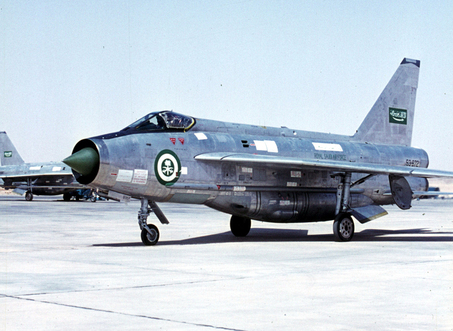
English Electric Lightning F.53 - 53672 - Photo via Hugh Trevor
On 19 October 1966 the first F.53, 53-666 took to the air. The F.53 was effectively a ground attack version of the F.6 and carried more than just air to air missiles. Hardpoints above and below the wing of the F.53 allowed it to carry a variety of stores.
Those below allowed the fitting of Matra 155 SNEB 68mm rocket pods. The over wing pylons could carry JL100 Pods which contained an 18-round SNEB rocket launcher in front and a 50 Imperial gallon fuel tank in the back. The pylons could also carry a pair of 1000Ib bombs and a parachute retarded version could be fitted to the over wing pylons.
The Red Top missiles could be replaced with a Microcell unguided rocket pack or a day and night reconnaissance tray. 30mm Aden cannons were also an option for fitting to the front of the ventral tank.
Those below allowed the fitting of Matra 155 SNEB 68mm rocket pods. The over wing pylons could carry JL100 Pods which contained an 18-round SNEB rocket launcher in front and a 50 Imperial gallon fuel tank in the back. The pylons could also carry a pair of 1000Ib bombs and a parachute retarded version could be fitted to the over wing pylons.
The Red Top missiles could be replaced with a Microcell unguided rocket pack or a day and night reconnaissance tray. 30mm Aden cannons were also an option for fitting to the front of the ventral tank.
Six T.55 were also ordered which were equally or more capable as the F.53s, due to having a second crew member who could act as a weapons operator. The first T.55, 55-710, flew from Warton in October 1966. Training of RSAF pilots took place at RAF Coltishall under the auspices of 226 OCU. The T.55s arrived at Coltishall in September 1967 with the last ones departing in 1969. By mid 1969 the RSAF had three operational Lightning squadrons, 2, 6 and 13.
Problems with Yemen continued into 1970 and just before peace was declared an RSAF Lightning, F.53 53-697, was hit by ground fire close to the Yemeni border. This was the only RSAF Lightning loss to hostile action while conducting operations.
Problems with Yemen continued into 1970 and just before peace was declared an RSAF Lightning, F.53 53-697, was hit by ground fire close to the Yemeni border. This was the only RSAF Lightning loss to hostile action while conducting operations.

English Electric Lightning F.53 - ZF582 (53-676) - Photo Richard Hall
In January 1986 the Lightning was withdrawn from RSAF service. A deal was struck with BAe for a replacement aircraft type and part of this was a return to the UK of the Lightnings.
The jets were ferried back to the UK in the hope they could be refurbished and sold to Denmark or Austria, however, this fell through. The Lightnings were then offered to museums or other interested parties, while others were scrapped often with the cockpit surviving into preservation.
The jets were ferried back to the UK in the hope they could be refurbished and sold to Denmark or Austria, however, this fell through. The Lightnings were then offered to museums or other interested parties, while others were scrapped often with the cockpit surviving into preservation.

English Electric Lightning F.53 - 53-670 - Photo Richard Hall
Another Lightning F.53 that found its way back to the UK was ZF578 (53-670). The aircraft now resides at Tangmere Military Aviation Museum in the guise of XR753 of 23 Squadron.
Kuwaiti Air Force

English Electric Lightning T.55 - 55410 (A) - Photo Phil Isaac via Hugh Trevor
The Kuwaiti Air Force (KAF) ordered 14 Lightnings, 12 F.53Ks and two F.55Ks. There were difficulties keeping this small force in the air and in 1973 the aircraft were offered for sale. There was little interest, however, the KAF kept the Lightnings flying until 1977. They were all then grounded and replaced by the Mirage F.1K.
Although not achieving big sales as an export, the Lightning did achieve good results in the Middle East and could be considered as a success in that field of operation.
Although not achieving big sales as an export, the Lightning did achieve good results in the Middle East and could be considered as a success in that field of operation.